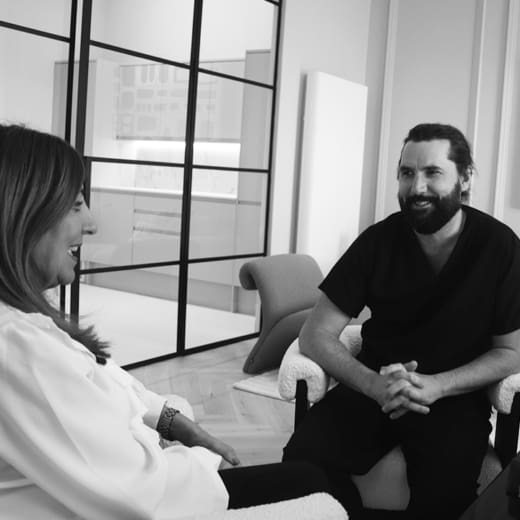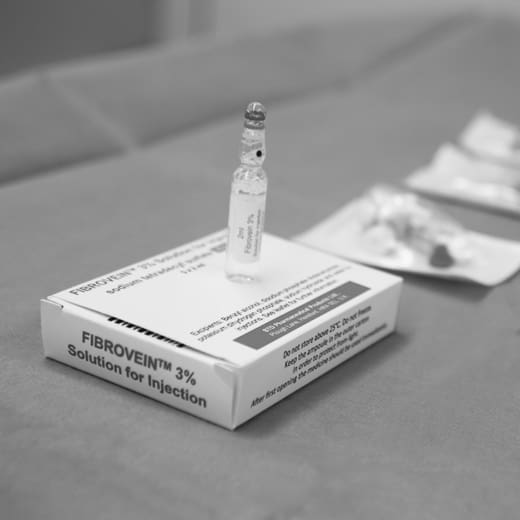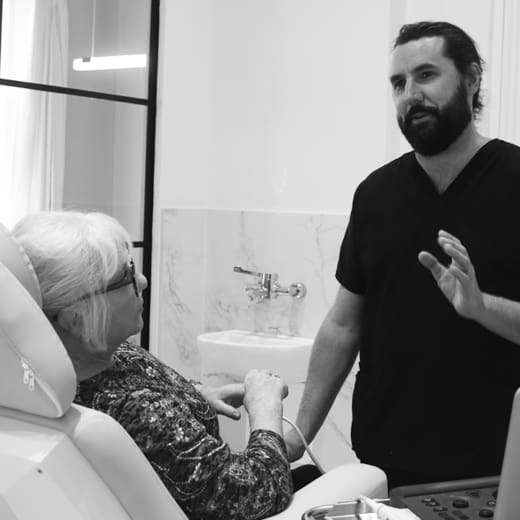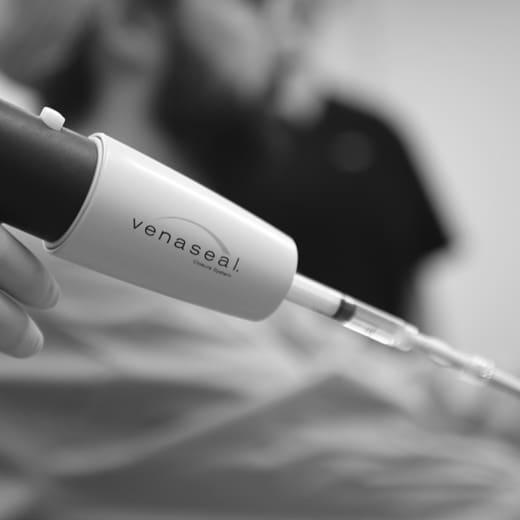McKeown Medical
167 Bath Street, Glasgow, G2 4SQ
Phlebectomy, or microphlebectomy, is a minimally invasive surgical procedure used to remove varicose veins.
Date posted — 24.09.24
Phlebectomy, or microphlebectomy, is a minimally invasive surgical procedure used to remove varicose veins. During the procedure, small incisions are made in the skin, typically around 1-2 millimetres in size, to access and extract the affected veins. The veins are carefully removed using specialised tools. It is performed under local anaesthetic injections to simply numb the skin, as opposed to the general anaesthetic used in more major varicose vein surgery.
The benefit of phlebectomy or microphlebectomy is its effectiveness in treating visible varicose veins, particularly those that are large or protruding. The procedure typically results in minimal scarring and a relatively quick recovery time. Patients can usually resume normal activities within a few days, although some may experience mild discomfort, bruising, or swelling in the treated area.
Phlebectomy is often performed in conjunction with other vein treatments, such as radiofrequency ablation (RFA) or VenaSeal™, to achieve optimal results and comprehensive vein care.
Dr Alex Vesey is our expert consultant vascular surgeon who heads up our varicose vein team. Listen to him explain the microphlebectomy treatment.

Microphlebectomy might be a suitable option for you if you have visible, bulging varicose veins that are not adequately addressed by other treatments or if they are causing significant discomfort.
This procedure is especially effective for larger veins that are close to the surface of the skin. These visible veins near the surface are usually caused by deeper diseased veins, and so the first port of call is always to treat the deeper underlying cause – either using RFA or VenaSeal™ (or, in uncommon cases, surgery). Treating the deeper diseased veins may result in the smaller, visible veins improving over time. However, it is often necessary to add in an extra treatment for the superficial veins – which is where microphlebectomy is helpful.
The alternative to microphlebectomy is foam sclerotherapy. The benefit of microphlebectomy over foam is that it is a more guaranteed result because the vein is being physically removed. The downside is that it’s slightly more invasive, rather than just an injection.
Before: Before the procedure, you’ll have a consultation with a consultant vascular surgeon to identify the best treatment option or options for your particular condition. On the day of the procedure, you’ll be taken to our minor operating room and asked to lie on a bed. The nurse will then clean your leg and attach some sterile drapes.
During: The procedure is performed under local anaesthetic, which numbs the area where the incisions will be made. You’ll remain awake and alert throughout the procedure, but you should feel little to no discomfort. Small incisions, usually about 1-2 millimetres in size, are made in the skin near the affected veins. Using specialised instruments, the doctor will gently remove the varicose veins through these tiny incisions. The procedure is guided by visual inspection and sometimes ultrasound imaging to ensure accuracy. Once the veins are removed, the incisions typically are so small they do not need a stitch and a simple plaster is applied. A compression stocking is then applied to help reduce discomfort and swelling.
After: After the procedure, you may experience mild discomfort, bruising, or swelling, but these symptoms generally resolve within a few days. You’ll be able to walk immediately after the procedure and can usually resume normal activities within a day or two. You will need to wear compression stockings for a week or two, and we will see you back in the clinic when you are healed to check on the final outcome.

Both phlebectomy and foam sclerotherapy are effective treatments for small, visible varicose veins, but they offer different benefits depending on the specific needs of the patient.
Phlebectomy is particularly beneficial for treating larger, more prominent varicose veins that are close to the surface of the skin. The main advantages of phlebectomy include its direct approach to removing the veins, which can provide immediate and visible results. The procedure involves making small incisions to extract the affected veins, and it is highly effective for veins that are resistant to other treatments.
Phlebectomy typically results in minimal scarring and a relatively quick recovery, with most patients resuming normal activities within a few days. It is especially useful for veins that are too large or complex for foam sclerotherapy to address effectively.
Foam sclerotherapy, on the other hand, is a less invasive treatment that involves injecting a foam sclerosant into the veins to cause them to collapse and eventually be absorbed by the body.
The advantages of foam sclerotherapy include its ability to treat multiple veins in one session and its non-surgical nature, which avoids the need for incisions. It is well-suited for smaller veins and can be effective for treating veins that are not as bulging or prominent. Foam sclerotherapy generally requires fewer sessions for smaller veins and has a shorter recovery time, with patients able to resume normal activities shortly after treatment. The main disadvantage of foam is that it usually requires multiple sessions.
Ultimately, the choice between phlebectomy and foam sclerotherapy depends on factors such as the size and location of the varicose veins, your overall health, anatomy and your treatment goals.
All of these factors are analysed as part of your initial consultation with our expert vascular surgeon to determine the best course of treatment for you as an individual. The first step is to fill in our online consultation form, and from there, our team will be able to arrange an initial consultation and ultrasound scan, and we can work together to create a treatment plan that is tailored to your needs.

Varicose veins are enlarged, twisted veins that often appear just under the skin, primarily in the legs and feet.

When it comes to treating varicose veins, VenaSeal™ has emerged as a revolutionary option that offers a minimally invasive and...

Foam sclerotherapy is an advanced form of sclerotherapy used to treat larger varicose veins, particularly those that may not respond...
1 / 3
2 / 3
3 / 3

Varicose veins are enlarged, twisted veins that often appear just under the skin, primarily in the legs and feet.

When it comes to treating varicose veins, VenaSeal™ has emerged as a revolutionary option that offers a minimally invasive and...

Foam sclerotherapy is an advanced form of sclerotherapy used to treat larger varicose veins, particularly those that may not respond...
Laser rejuvenation of the eye area can be an incredibly powerful tool for the right patients, especially those whose ‘bags’ are more about loose skin and fine lines, like this lovely patient here.
We treated her with full field ablation, which takes around 2 weeks to recover from. Her she is a few weeks later and you can see how much tighter the skin is, the crepey skin has gone and the fine lines have been ironed out. The patient is over the moon.
What do you think?

Eyelid surgery is one of the most popular procedures we do in the clinic. It’s a great fix for hooded eyes! Excess skin on the upper eyelids can not only create a hooded, heavy appearance but often affects the vision too.
Here’s the very talented @bramhallplasticsurgery discussing how upper eyelid surgery (blepharoplasty) can restore a more open, refreshed look by removing the excess skin and subtly redefining the natural eyelid crease. Scars are hidden within the fold of the eyelid, leaving eyes that look brighter, not “done.”
Do you have any questions about surgery? Ask in the comments or send us a message!

Thank you to our patient for allowing us to share her before and after photos of her upper blepharoplasty.
Excess skin on the upper eyelids can make the eyes appear tired or heavy. This simple procedure restores a lighter, more open look while keeping the result completely natural.
Another fabulous result from the very talented @bramhallplasticsurgery!
What do you think?

We’ve been in our new home for a year now and I thought this would be a good time to remind you just how special it is with a little video tour.
It’s been a remarkable year for us in our new home; we’ve introduced new doctors, new treatments, new services and our team continues to grow from strength to strength - always striving to provide more and better for our wonderful patients.
Enjoy the tour!

About last night… It was time once again for our annual Christmas celebration with this absolute bunch of legends. We were a little earlier than usual this year so we could have has many people available as possible, and the evening did not disappoint.
A few sore heads this morning, but absolutely worth it to celebrate the hard work this team dedicate to our patients day in, day out all year round. I am very proud to have the undisputed best team on the planet. Merry Christmas everyone! 🎄

Fine lines etched into the skin around the mouth - this is a common problem and in this patient`s case she had what we call ‘actinic elastosis’, whereby abnormal bands of elastin build up in the skin as a result of years of previous sun exposure.
When patients have this condition, the gold standard way of dealing with it is fully ablative laser resurfacing. It’s an intense treatment with two weeks of downtime afterwards, but the results are spectacular - just like in this lovely patient.
The after photo is three weeks after the treatment and you can see that the skin is still a little pink, which will continue to fade over the next few months.
The patient is already delighted with the result - what do you think?

It’s beginning to look a lot like Christmas!
At least according to Michael Buble, who’s been on repeat in the clinic this week. The decorations are up and we are officially in ‘our season’. The clinic has been packed with everyone having their skin polished in time to make it on the nice list. If you’ve still to make a pre-Christmas appointment, we’ve still got some spaces left for your festive glow up.
Ho ho ho everyone… It’s time for Santa!!!! 🎅🏻

Ok, so this is the one we’ve all been waiting for. Sofwave : the results, in our hands!!!
This is the first patient we treated with @sofwave.uk when we were assessing the machine and deciding whether or not to buy it. These are the patient`s own photos that she kept throughout the healing journey.
Now do you see why we are so excited?! 🤩
#sofwave
#sofwavemed
#SUPERB
#sofwavemedical
#sofwavejourney
#sofwaveexperience

We are now well up and running with @sofwave.uk , much to the excitement of the whole team in the clinic (we are all queuing up to get a shot!)
This is a little video of the treatment being performed, so you can see what the process is like and there is even a little early preview of the results at the end.
One of the best parts is that there is no downtime, so we can still fit it in before Christmas without worrying about redness in the party season!
What do you think?
#sofwave
#sofwavemed
#SUPERB
#sofwavemedical
#sofwavejourney
#sofwaveexperience
